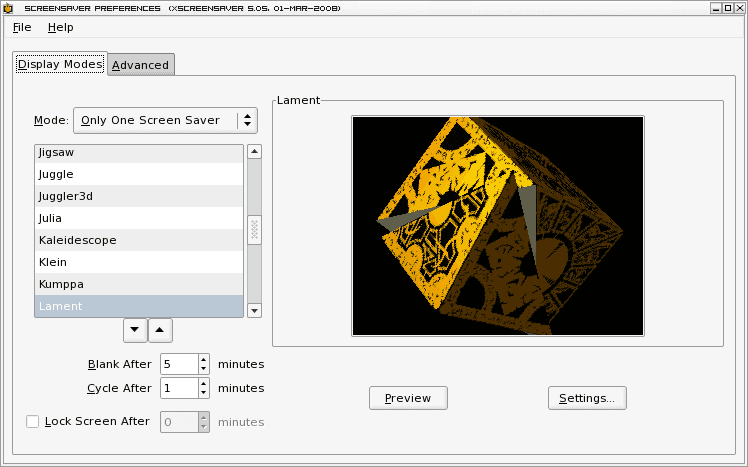

Xscreensaver: 00:58:14: 0: child pid 8395 (fiberlamp) terminated with signal 15. Xscreensaver: 00:57:14: 0: spawning "fiberlamp -root" in pid 8395. Xscreensaver: 00:57:14: 0: child pid 8393 (glmatrix) terminated with signal 15. Xscreensaver: 00:57:14: 0: destroyed old saver window 0x2e0000c. Xscreensaver: 00:56:14: 0: child pid 8392 (glschool) terminated with signal 15. Xscreensaver: 00:56:14: 0: spawning "glmatrix -root" in pid 8393. Xscreensaver: 00:56:14: 0: destroyed old saver window 0x2e00009. Xscreensaver: 00:55:14: 0: spawning "glschool -root" in pid 8392. (You will have to logout and login for this setting to take effect)Ī sample of the log created contains just what you were looking for: a way of identifying which screensavers were playing in a random session (I have shortened the log as it is extremely verbose) xscreensaver 5.15, copyright (c) 1991-2008 by Jamie Zawinski. If you want to revert to the default setting, just change the commands back in the file or delete $HOME/.config/xfce4/xinitrc so that no custom xfce4 xinitrc settings are applied on login. Now change the two occurences of xscreensaver -no-splash &Īt around lines 199 and 208 (in my version) to xscreensaver -verbose -no-splash -log /home/$USER/xscreen1.log & If you want xscreensaver to always save its data to a log (passwords used to unlock screens are not copied to the log), first copy xfce4's systemwide xinitrc to your home folder: cp /etc/xdg/xfce4/xinitrc $HOME/.config/xfce4/xinitrc More 'permanent' setting (example used is for Xfce)

(The settings changed by xscreensaver-demo are saved in ~/.xscreensaver.) Now when the timeout you specified is reached, xscreensaver will start and write to the log. This command launches the xscreensaver daemon process with the verbose option so that it reports on exactly what it does, which is then saved in the specified log.įor this experiment, run xscreensaver-demo to set the screensaver options to random, and choose very low 'blank after' and 'cycle after' values in the settings. So if you want to load up xscreensaver with different options just for that session (until you log out), you can kill any running instances with killall xscreensaverĪnd then launch it with the appropriate new parameters: xscreensaver -verbose -no-splash -log /home/$USER/xscreen2.log & Your user session, whether it is Gnome or Xfce, will usually auto-load xscreensaver with the options xscreensaver -no-splash &, as it does in Xfce, for example, using the file /etc/xdg/xfce4/xinitrc. Indeed, there is a way to show this information via a log, and it is usually used for debugging purposes.


 0 kommentar(er)
0 kommentar(er)
